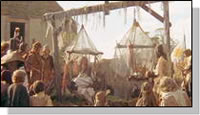
Caveat – the pictures throughout this article have little to do with the text – but it’s my favorite movie – so what can I say – it’s what we do.

To say that 2009 will be a watershed year in the financial services business would be a bloody understatement, mates. We have had our share of difficulties in the past, including the demise of many a bank and thrift institution, and we are still open for business. You have read our collective thoughts on the TARP – and now for something entirely different. This year, we see that our Gonzo credit union counterparts, knights brave and true, are not immune to the damage that can be done by regulatory bureaucracy – there’s trouble in Camelot.
As you know by now GonzoBankers, the all-knowing writers of this humble Web newsletter at Cornerstone Advisors acknowledge, respect and support Gonzo leaders from all corners of the financial services industry. Innovative FI managers that pay attention to their customers and treat them fairly, keep their spending under control and don’t get complacent have always managed to grow and prosper, no matter what happens inside the beltway.
At the same time, we are reminded that the fate of our nation appears to be doomed to repeat a series of cyclical boom and bust periods from which we learn little as we rush headlong in pursuit of the next easy stream of revenue. We don’t seem to be good at remembering the carnage we left behind; we are too busy looking for green shoots in the rubble – and we always seem to manage to find some.
This week we turn our attention to the current regulatory mayhem going on in Credit Union Land and add our voice to the growing clamor against the lack of due diligence that helped create the “corporate credit union crisis.” Given the turn of events, we wonder if it is wise for so many out-of-work bankers to continue to apply for top management positions in credit unions.
Witness the current difficulties within the corporate credit union system created by a prolonged lack of attention and oversight, followed by what some have characterized as an over-reaction by the National Credit Union Administration and premature conservatorship of the two largest corporate credit unions – U.S. Central FCU and Western Corporate FCU.
The players in this saga include the NCUA (the Regulator); PIMCO (the Consultant); the management and boards of corporate credit unions (the Knights of the Round Table); and last but not least, all natural person credit unions that are left paying the check (the Paupers).

The Regulators – Holy but not Righteous
Over the years, some of the carnage in the financial services industry can be laid at the door of our esteemed elected officials and federal regulators that carry out their collective will for the good of the people. The model of old remains the same to this day: legislative changes create incentives that lead to increased systemic risk coupled with a lack of due diligence on the part of boards of directors and regulators, followed by panic and a series of reactionary decisions that arbitrarily destroy capital and decimate good franchises that took decades of blood, sweat and tears to build. We know from the Savings and Loan debacle of the mid-1980s that the government (led by Congress) is fully capable of removing safeguards, creating harmful incentives that help create a crisis, and then ultimately wiping out entire industries by over-reacting to the crisis it helped create. No need to mention Fannie and Freddie.
 The Corporate Credit Unions
The Corporate Credit Unions
Corporate credit unions have been around for a long time and have served a very useful purpose providing liquidity, payment processing and settlement, pooled investments and risk management services for credit unions. The cost of payment services made available to credit unions was in part subsidized by the corporate credit unions’ treasury operations, giving credit unions the ability to compete in all delivery channels. It’s true that many of the corporates have been allowed to expand beyond regional boundaries and in numbers beyond what was necessary. It’s true they were allowed to compete with each other for members, capital and deposits – and because of the competition, began to look for ways to generate greater and greater returns for their member credit unions.
It’s also true that in recent years they were allowed to invest in a broader array of mortgage and asset backed securities, blessed by the likes of Standard & Poor’s, that condoned a world of increasing yields with minimal risk. Like most banks and thrifts, they were “conservative” and purchased only the highest quality investments, mostly AAA rated. But as proved to be the case with many other institutions, the concentration risk was ignored based on the assumption that the underlying assets were completely safe and nothing could go wrong. To their credit, some corporate credit unions proceeded more conservatively. Others did not, including the largest retail corporate, Western Corporate FCU, and the largest wholesale corporate credit union, U.S. Central FCU. Both corporate credit unions, recently conserved, had federal examiners on premises full time. On-site examiners acquiesced to increasing percentages of asset backed securities held in corporate portfolios. Western Corporate FCU was allowed to build its asset and mortgage backed securities to more than 70% of its total investment portfolio. When the securities began to be devalued by the rating agencies, the regulators took notice and moved in.
 Corporate Credit Union Directors
Corporate Credit Union Directors
Natural person credit unions are the member-owners of corporate credit unions. The elected directors of the corporate credit unions come from the CEO ranks of member credit unions and from national trade associations — all very smart and diligent folk. While little press attention has been placed on board oversight so far, it strikes me as somewhat curious that corporates’ directors would allow for such concentration risk in their respective investment portfolios when they would never consider the same strategy for their own credit unions, nor would their boards, external auditors or federal examiners ever let them get away with it. In fairness, the same concentration issues could be leveled at large banks, investment managers, hedge funds and the Federal Home Loan Banks.
 Hail the Outside Consultant
Hail the Outside Consultant
So what happens when the market freezes over for this class of asset-backed investment? The NCUA, suddenly woken up to the portfolio composition, elected to retain an “outside consultant” to come in and assess the damage at the corporates. That consultant was PIMCO. In a strange twist of irony, PIMCO is an investment company well known for purchasing distressed assets at deep discounts. I’m not sure if PIMCO is even interested in the coporates’ assets but it is a bit like a home buyer being given the opportunity to appraise the home they want to make an offer on. The NCUA, augmenting its own analysis with PIMCO’s, mandated the immediate write-down of all corporate credit union asset-backed securities, resulting in the impairment of capital based on future projected losses.
 The Holy Hand Grenade
The Holy Hand Grenade
The results from the action to conserve the two largest corporate credit unions on March 20, 2009 are severe. The NCUA estimated the size of the projected credit losses to be $10.8 billion and the resulting liability to the National Credit Union Share Insurance Fund to be $5.9 billion. Since the capital ratio of the NCUSIF is mandated by law at 1.2% of assets, the individual insured credit unions have also been tapped to absorb the potential loss to the insurance fund though an additional “one-time” cash assessment – this equated to about 50 – 60 basis points of capital for most credit unions.
 Credit Union Leaders Revolting
Credit Union Leaders Revolting
As you can imagine, a growing number of credit union leaders are now questioning the motives and competence of their own regulator, even though it appears that the regulator went through a difficult but thoughtful process, and then did what it felt it had to do. Some of the issues that have me scratching my head are the following:
 Predictions About the Future of Credit Unions
Predictions About the Future of Credit Unions
For the bankers, credit unions, vendors, regulators and industry pundits in the Gonzo readership, I offer the following predictions concerning the future of the credit union industry:
 We at GonzoBanker have always tried to take an independent and unbiased point of view related to these high-level goings-on. Our interest is more in helping bankers and credit union leaders make the best decisions for their respective institutions with regard to competitive strategy, service innovation and technology, organizational best practices and profitability. If you don’t ultimately make money and satisfy customers, it doesn’t matter what kind of charter or statutory protections you have.
We at GonzoBanker have always tried to take an independent and unbiased point of view related to these high-level goings-on. Our interest is more in helping bankers and credit union leaders make the best decisions for their respective institutions with regard to competitive strategy, service innovation and technology, organizational best practices and profitability. If you don’t ultimately make money and satisfy customers, it doesn’t matter what kind of charter or statutory protections you have.
 As for the current difficulties, what doesn’t kill ye makes ye stronger.
As for the current difficulties, what doesn’t kill ye makes ye stronger.The photos came from Monty Python’s Completely Useless Website – certainly more useful that a dead parrot.
Annual planning content this year will likely be much more about containing operating expenses than about increasing market share.
Cornerstone Advisors has helped numerous financial institutions save millions of dollars in operating costs by uncovering major opportunities for process improvements and efficiency.
Visit our Web site or contact us to discuss how Cornerstone can help your organization control operating costs and increase its overall effectiveness.